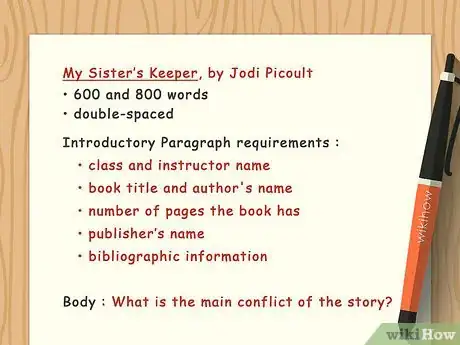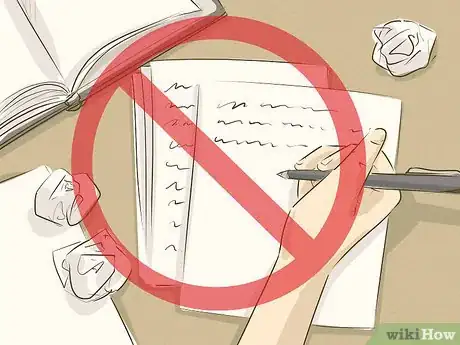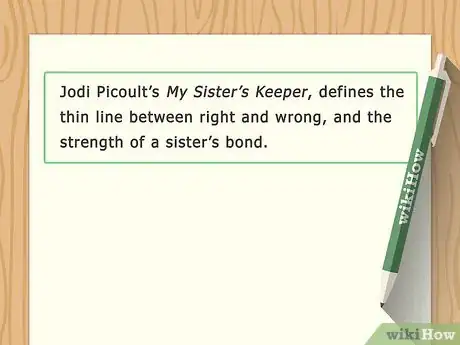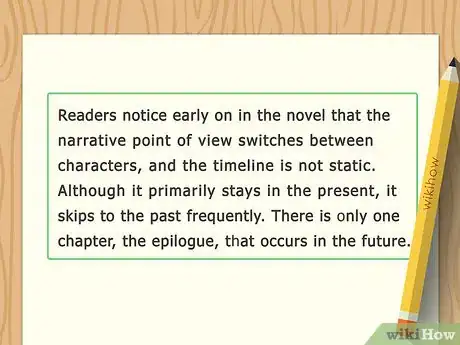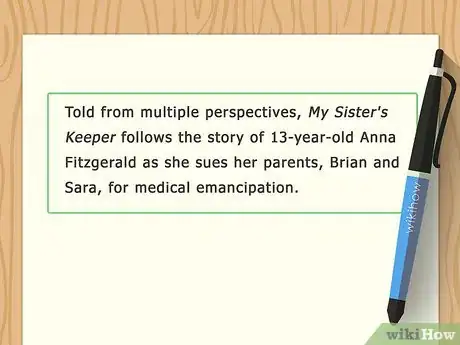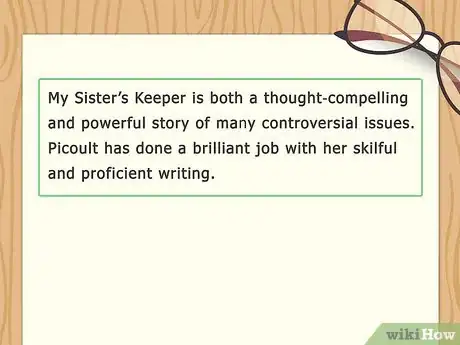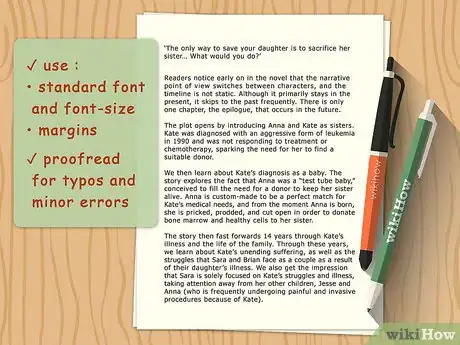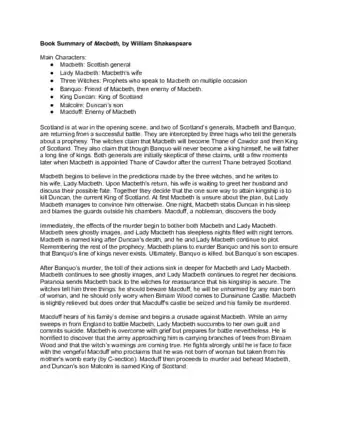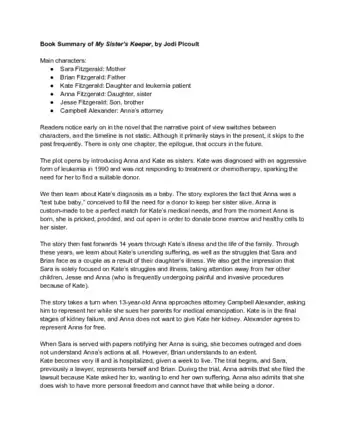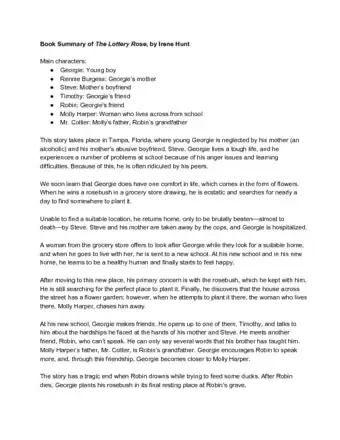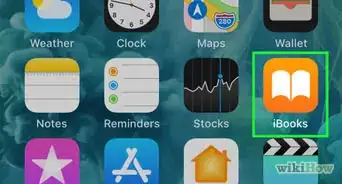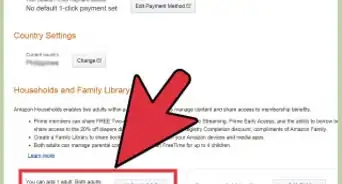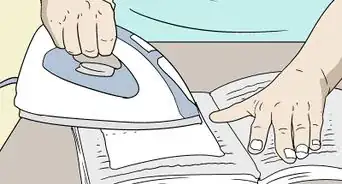This article was co-authored by Jake Adams. Jake Adams is an academic tutor and the owner of Simplifi EDU, a Santa Monica, California based online tutoring business offering learning resources and online tutors for academic subjects K-College, SAT & ACT prep, and college admissions applications. With over 14 years of professional tutoring experience, Jake is dedicated to providing his clients the very best online tutoring experience and access to a network of excellent undergraduate and graduate-level tutors from top colleges all over the nation. Jake holds a BS in International Business and Marketing from Pepperdine University.
There are 9 references cited in this article, which can be found at the bottom of the page.
This article has been viewed 1,373,651 times.
Writing a book report may not seem fun at first, but it gives you a great chance to really understand a work and its author. Unlike a book review, a book report requires that you give a straightforward summary of the text. Your first step is to pick up the book and start reading. Take detailed notes and annotations as you go along. These will help you to build a solid outline, which will make the writing process much easier.[1]
Steps
Researching and Outlining Your Report
-
1Follow the requirements of your assignment. Read through the assignment sheet carefully and make note of any questions that you have. Raise your hand during class or talk with your teacher afterward to go over any concerns. Make sure that you know the required paper length, due date, and any formatting requirements, like double-spacing.
- For example, you’ll need to find out if your teacher wants you to include citations, such as page numbers from the book, in your paper.
- It’s also a good idea to ask your teacher how much of your paper you should devote to summary versus analysis. Most book reports are direct summaries with only a few opinions mixed in. In contrast, a book review or commentary is more opinion-driven.
- Check what kinds of topics you might be asked to write on from the book, so you'll know what to be on the lookout for as you read.[2]
-
2Read the entire book. This is the most important step. Before you even think about writing, sit down and read the text. Find a quiet place where you can concentrate on the book and nothing else. It helps to keep your paper in mind as you read, paying particular attention to any important plot points or characters.[3]
- Read in stretches with breaks in between to keep your attention sharp. Try to find a pace that is comfortable for you. If you get distracted after 15 minutes, read in 15-minute intervals. If you can go an hour, read for an hour at a time.
- Make sure to give yourself enough time to get through the entire book. It’s very difficult to write a book report if you’ve just skimmed over everything.
- If you're reading a digital book, you can even make bookmarks that will be easily searchable once you have to write your report.[4]
- Don’t trust online book summaries. You can’t guarantee that they are accurate or true to the text.
Advertisement -
3Take careful notes when reading. Keep a pencil, highlighter, or sticky notes handy as you read. If you prefer to work with your phone or a computer, open up a work document and take all your notes there. If you find something that you are curious or confused about, mark it. When the author discusses a major plot point or character, do the same thing. Start identifying evidence and details that you can use in your report by bracketing or placing a note by quotations or good examples.[5]
- For example, look for a sentence that clearly describes a main setting in the book, such as, “the castle was gloomy and made out of large black stones.”
-
4Create an outline. This should be a paragraph-by-paragraph listing of how your paper will be organized. Include what each paragraph will discuss and the details from the work that you’ll include. Expect that this outline might change a bit when you start writing. Writing often leads to its own realizations, so have a plan but be flexible.[6]
- When you are finished with your outline, go back through it to see if it makes sense. If the paragraphs don’t flow into one another, move them around or add/delete new ones until they do. Also, check to see if your outline covers all of the major elements of the book, such as the plot, characters, and setting.
- Outlining does take a bit of time, but it will save you time in the editing stage.
- Some people prefer to outline with pen and paper, while others just type up a list on the computer. Choose the method that works the best for you.
-
5Intermix examples and quotations from the text. As you construct your outline, try to pair any general points of summary with specific details from the book. This will show your teacher that not only have you read the book, you understand it. Vary your examples and keep your quotations brief.[7]
- Be careful not to overuse quotes. If it seems like every other line is a quote, try to dial back. Aim to include a maximum of one quotation per paragraph. Quotes and examples should still take a backseat your summary.
-
6Don’t try to cover everything. It’s just not possible to discuss every piece of the book thoroughly. So, don’t set yourself up for failure by trying to do this. Instead, make sure that your report includes the most important ideas and gives your reader a real feel for the book.[8]
- For example, you’ll likely need to focus primarily on discussing the most important characters or the characters that appear most frequently in the text.
Writing the Body of Your Report
-
1Open with an informative intro paragraph. In your first paragraph, you should include the author’s name and the book title. You should also open with a line that will grab your reader’s attention, such as an interesting quote from the book. It’s good to put a general, one sentence summary of the entire work in the last line of your introduction.[9]
- For example, a sentence summary might state, “This book is about the main character’s journey to Africa and what she learned on her travels.”
- Don’t take up too much space with your introduction. In general, an introduction should be 3-6 sentences long, though in rare cases they may be shorter or longer.
-
2Describe the book’s setting. This is a great way to start the body of your paper because it will set the stage for everything else that you’ll discuss in your report. Try to describe the locations mentioned in the book so that your teacher will know exactly what you are referring to. If the story takes place on a farm, go ahead and say so. If the setting is imaginary or futuristic, make that clear as well.[10]
- Use vivid language when you can and plenty of details. For example, you might write, “The farm was surrounded by rolling hills.”
-
3Include a general plot summary. This is where you describe exactly what happens when in the book. Your plot summary should mention any major events that take place in the book and how they impact the characters. This portion of your report should appear akin to a detailed outline of the book itself.
- For instance, if the main character moves to Africa, you might describe what happens before the move, how the move goes, and how they settle in once they arrive.
-
4Introduce any main characters. As you mention each character in your report, make sure to introduce who they are and why they are important in the book. You can also devote an entire section of your report to describing the primary characters focusing on everything from what they look like to their most important actions.
- For example, you might write that the main character of the book is, “a middle-aged woman who enjoys the finer things in life, such as designer clothes.” Then, you could connect this to your plot summary by describing how her views change after her travels, if they do.
- Character introduction will likely happen in the same sentences and paragraphs as plot introduction.
-
5Examine any main themes or arguments in your body paragraphs. Look for the ‘big ideas’ as you are reading. In a fiction work, pay attention to the character’s actions and how they follow certain patterns, if they do. In a nonfiction work, look for the author’s primary thesis statement or argument. What are they trying to prove or suggest?[11]
- For example, you might write, “The author argues that travel gives you a new perspective. That is why her main characters all seem happier and more grounded after visiting new places.”
- For a fiction work, watch to see if the author is using the story to pass along a certain moral or lesson. For example, a book about a fictional underdog athlete could be used to encourage readers to take chances to pursue their dreams.
-
6Comment on the writing style and tone. Look over sections of the work once more and pay particular attention to writing elements, such as word choice. Ask yourself whether or not the book was written in a formal way or more informally. See if the author seems to favor certain ideas and arguments over others. To get a feel for tone, think about how you feel when you read parts of the book.[12]
- For example, an author who uses lots of slang terms is probably going for a more hip, approachable style.
Finishing Up Your Report
-
1Write a concise conclusion. Your concluding paragraph is where you pull everything together for your reader. Include a few quick sentences summarizing the entire book. You can also make a final statement about whether you’d suggest the book to other readers and why.[13]
- Some teachers require, or strongly suggest, that you include the author’s name and title in your concluding paragraph.
- Don’t introduce any new thoughts in this final paragraph. Save the space for your recap.
-
2Edit your paper. Re-read your paper two times, at least. The first time concentrate on making sure that the structure makes sense and that each paragraph is clear. The second time proofread it to look for small errors and typos, such as missing commas or quotation marks. It can also help to read your paper aloud to check for awkward phrasing.[14]
- Before you submit your paper, make sure that you’ve spelled the author’s name and any character names correctly.
- Don’t trust your computer’s spell check to catch any errors for you.
-
3Ask someone else to read it. Go to a family member, friend, or classmate and ask if they’ll read through your report. Tell them that you’d really appreciate if they jotted down comments or corrections on the page margins. You could also talk with them afterwards to get any suggestions.
- For example, you might say, “It would be great if you could go over my report and make sure that it reads smoothly.”[15]
-
4Polish your final report. Once you’ve made all of the corrections, print out a clean version of your report. Read through it slowly and carefully. Look for any typos or minor errors. Compare your report to the guide sheet to make sure that you’ve followed all of your teacher’s directions.
- For example, double-check that you are using the correct font, font size, and margins.
Sample Book Report and Summaries
Expert Q&A
Did you know you can get expert answers for this article?
Unlock expert answers by supporting wikiHow
-
QuestionWhat are the steps to write a book report?
 Jake AdamsJake Adams is an academic tutor and the owner of Simplifi EDU, a Santa Monica, California based online tutoring business offering learning resources and online tutors for academic subjects K-College, SAT & ACT prep, and college admissions applications. With over 14 years of professional tutoring experience, Jake is dedicated to providing his clients the very best online tutoring experience and access to a network of excellent undergraduate and graduate-level tutors from top colleges all over the nation. Jake holds a BS in International Business and Marketing from Pepperdine University.
Jake AdamsJake Adams is an academic tutor and the owner of Simplifi EDU, a Santa Monica, California based online tutoring business offering learning resources and online tutors for academic subjects K-College, SAT & ACT prep, and college admissions applications. With over 14 years of professional tutoring experience, Jake is dedicated to providing his clients the very best online tutoring experience and access to a network of excellent undergraduate and graduate-level tutors from top colleges all over the nation. Jake holds a BS in International Business and Marketing from Pepperdine University.
Academic Tutor & Test Prep Specialist
-
QuestionDespite all of this, I still do not know how to begin. Is there a simpler step to get me into the work zone?
 Alexander Peterman, MAAlexander Peterman is a Private Tutor in Florida. He received his MA in Education from the University of Florida in 2017.
Alexander Peterman, MAAlexander Peterman is a Private Tutor in Florida. He received his MA in Education from the University of Florida in 2017.
Test Prep Tutor I would start with speaking with your teacher once you've picked out your book and read it. Specifically, ask them what they would like you to accomplish with the book report so you have an idea of what they are looking for when they grade you. Try to come into the discussion with at least one major theme of the book picked out.
I would start with speaking with your teacher once you've picked out your book and read it. Specifically, ask them what they would like you to accomplish with the book report so you have an idea of what they are looking for when they grade you. Try to come into the discussion with at least one major theme of the book picked out. -
QuestionDo you have a standard sample of a book report?
 Community AnswerFirst, talk about the author. Then start talking about the book. After explaining its contents, give a final opinion about the book, including what you liked and what you didn't.
Community AnswerFirst, talk about the author. Then start talking about the book. After explaining its contents, give a final opinion about the book, including what you liked and what you didn't.
Warnings
- Stealing or using another person’s work is considered plagiarism and academic dishonesty. Make sure that the your that you submit is all your own.⧼thumbs_response⧽
- Give yourself plenty of time to write your report. Don’t wait until the last minute or you may feel rushed.[16]⧼thumbs_response⧽
References
- ↑ https://owl.english.purdue.edu/owl/resource/703/1/
- ↑ Jake Adams. Academic Tutor & Test Prep Specialist. Expert Interview. 24 July 2020.
- ↑ https://www.time4writing.com/writing-resources/writing-a-book-report/
- ↑ Jake Adams. Academic Tutor & Test Prep Specialist. Expert Interview. 24 July 2020.
- ↑ https://takelessons.com/blog/steps-to-writing-a-book-report
- ↑ https://owl.english.purdue.edu/owl/resource/703/1/
- ↑ https://www.teachervision.com/writing/writing-book-report
- ↑ https://www.infoplease.com/homework-help/homework-center-writing-book-report
- ↑ https://www.thoughtco.com/how-to-write-a-great-book-report-1857643
- ↑ https://www.usa.gov/book-report
- ↑ https://www.teachervision.com/writing/writing-book-report
- ↑ http://www.butte.edu/departments/cas/tipsheets/style_purpose_strategy/book_reports.html
- ↑ https://www.thoughtco.com/how-to-write-a-great-book-report-1857643
- ↑ https://owl.english.purdue.edu/owl/resource/703/1/
- ↑ https://www.time4writing.com/writing-resources/writing-a-book-report/
- ↑ https://takelessons.com/blog/steps-to-writing-a-book-report
About This Article
To write a book report, start by introducing the author and the name of the book and then briefly summarizing the story. Next, discuss the main themes and point out what you think the author is trying to suggest to the reader. Finally, write about the author’s style of writing, paying particular attention to word choice and the overall tone of the book. For tips on editing and polishing your paper before turning it in, keep reading!
